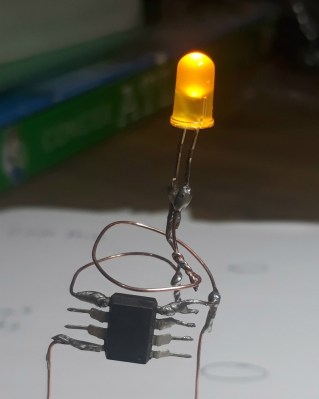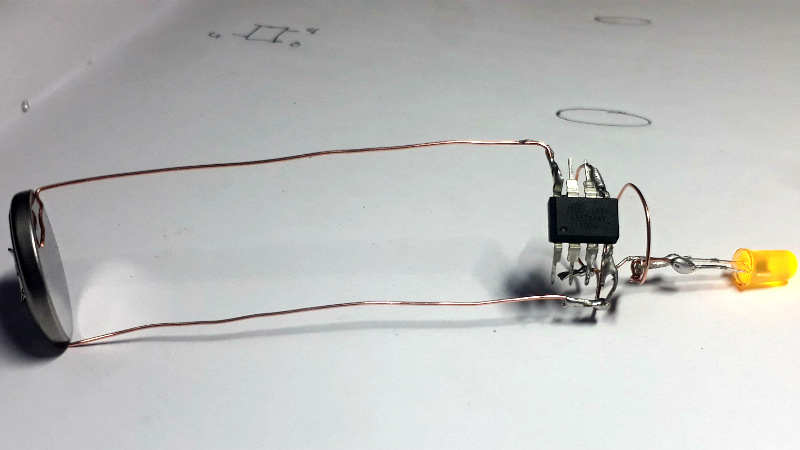Entries into the Circuit Sculpture Contest tend to be pretty minimalist by nature, and this LED candle by [Amal Mathew] is a perfect example. The idea here was to recreate the slim and uncomplicated nature of a real candle but with a digital twist, and we think he’s pulled it off nicely with a bare minimum part count and exaggerated wire length that gives it the look of a thin pillar candle.
 To give the LED a fading effect, [Amal] uses a ATtiny85 programmed with the Arduino IDE. His code uses the
To give the LED a fading effect, [Amal] uses a ATtiny85 programmed with the Arduino IDE. His code uses the analogWrite() in a loop to gradually increase and then decrease the PWM frequency. With the LED connected directly to one of the pins on the ATtiny85, the simple program achieves the fading effect without needing any additional components.
On the opposite side of the candle, connected by long copper wires, is the single CR2032 which provides power for the circuit. In a nice touch, [Amal] has turned the battery 90 degrees relative to the rest of the circuit, so it can serve as a weighted base. We imagine getting it to stand up might be a little fiddly from the looks of it, but once it’s up and merrily fading in and out, it really helps sell the candle idea.
The finished product might look fairly straight-forward, but in his write-up on Hackaday.io, [Amal] gives detailed instructions on how to build your own version if you’re not a bare microcontroller wizard. This includes direction on how to program the ATtiny85 using an Arduino Uno; a neat trick to know even if you aren’t planning on making any candles in the near future. The next logical step is making it so you can “blow out” the LED, which should only take the addition of a resistor and some updated code.
There’s still plenty of time to enter your own functional piece of art in the Circuit Sculpture Contest. Just write it up on Hackaday.io and submit it before the January 8th, 2019 deadline.
















Haha, there is something very absurd about it that I quite like! I think I must call this art.
Of course, candle flames don’t slowly dim and brighten, when they flicker, it’s intermittent, rapid and random. Perhaps digitally recording the luminosity of an actual candle over 20 or 30 minutes and then using that data (in a repeating loop) to control the intensity of the LED.
Good idea, but may use a lot of memory.
With all the data produced from recording, maybe a mathematical function or some kind of algorithm can be worked out.
I put together a Tiny85 candle that uses a ‘Walking Random’ program that produces a nice flicker effect.
About 30 times a second, it pics a random number between 0 and 255.If the number is grater than 126, it increments a value, if it is lower than 126, it decrements the value. Each time this value is transferred to the LED, using analogWrite().
Kind of like flipping a coin to see if you will take a step backwards or forward.